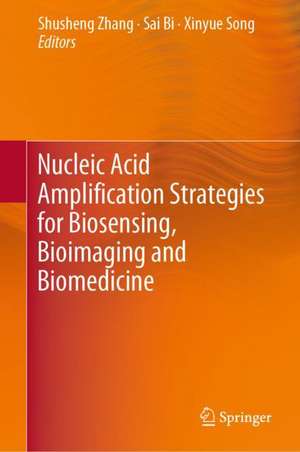Nucleic Acid Amplification Strategies for Biosensing, Bioimaging and Biomedicine
Editat de Shusheng Zhang, Sai Bi, Xinyue Songen Limba Engleză Hardback – 6 mai 2019
Preț: 953.65 lei
Preț vechi: 1162.99 lei
-18% Nou
Puncte Express: 1430
Preț estimativ în valută:
182.48€ • 191.04$ • 150.99£
182.48€ • 191.04$ • 150.99£
Carte tipărită la comandă
Livrare economică 07-21 aprilie
Preluare comenzi: 021 569.72.76
Specificații
ISBN-13: 9789811370434
ISBN-10: 9811370435
Pagini: 342
Ilustrații: XXI, 337 p. 152 illus., 140 illus. in color.
Dimensiuni: 155 x 235 mm
Greutate: 0.68 kg
Ediția:1st ed. 2019
Editura: Springer Nature Singapore
Colecția Springer
Locul publicării:Singapore, Singapore
ISBN-10: 9811370435
Pagini: 342
Ilustrații: XXI, 337 p. 152 illus., 140 illus. in color.
Dimensiuni: 155 x 235 mm
Greutate: 0.68 kg
Ediția:1st ed. 2019
Editura: Springer Nature Singapore
Colecția Springer
Locul publicării:Singapore, Singapore
Cuprins
Introduction.- Nucleic Acid Amplification Strategies-Based Chemiluminescence Biosensors.- Nucleic Acid Amplification Strategies-Based Electrochemiluminescence Detection.- The Application of Nucleic Acid Amplification Strategies in Photoelectrochemistry Technologies.- Nucleic Acid Amplification Strategies: Rational Design and Electrochemical Signaling.- Nucleic Acid Amplification Strategies-Based Nanopore Sensors.- DNA Amplification Strategies Based on QCM.- Nucleic Acid Amplification Strategies in Surface Plasmon Resonance Technologies.- The Application of Nucleic Acid Amplification Strategies in the Raman Spectra Technologies.- The Application of Nucleic Acid Amplification Strategies in the Single Molecule Detection.- The Application of Nucleic Acid Amplification Strategies in the Environmental Detection.- Fluorescence Techniques Based on Nucleic Acid Amplification Strategies: Rational Design and Application.- Nucleic Acid Amplification Strategies for in Vitro and in Vivo Imaging.- The Application of Nucleic Acid Amplification Strategies in Theranostics
Recenzii
“The book is a useful resource for researchers who want to start applying nucleic acid amplification strategies for the development of practical and very sensitive methods for detecting either specific nucleic acid sequences or other biomolecules using aptamers as specific receptors. … this compendium will inspire readers, paving the way for the development of new devices, which could reach the point of routine use in the laboratories.” (María Jesús Lobo-Castañón, Analytical and Bioanalytical Chemistry, Vol. 412, 2020)
Notă biografică
Shusheng Zhang received his PhD in Chemistry from Nanjing University in 1999. Currently, he is a Professor at Linyi University and Head of Shandong Provincial Key Laboratory of Detection Technology for Tumour Markers. He has been involved in six national projects, including the National Natural Science Foundation of China’s State Key Program and Major Instrumental Special Program, and the National Natural Science Funds for Distinguished Young Scholars. He has received six provincial-level awards and published 80 SCI-indexed papers. His current research interest is in using bioanalytical chemistry and molecular theranostics to develop specific and sensitive assays of tumor biomarkers for the early diagnosis of cancer.
Sai Bi received her PhD from Qingdao University of Science and Technology in 2010. She worked as a postdoctoral fellow at Nanjing University from 2012 to 2014, and is currently a Professor at the College of Chemistry and Chemical Engineering at Qingdao University. Her research interests focus on the construction of signal amplification chemiluminescence biosensors, biochemical analysis, DNA nanotechnology, molecular imaging and targeting therapy.
XinYue Song received her PhD in Chemistry from Lanzhou Institute of Chemical Physics, Chinese Academy of Sciences in 2016. Currently, she is a Full Professor at the College of Chemistry and Chemical Engineering, Linyi University. During her doctoral studies, she spent one year working on holographic biosensors at Cambridge University. Her current research interests include upconversion nanoparticles, in vitro and in vivo multi-mode imaging, and theranostics, and she has developed a novel imaging technology for tumor markers and theranostics based on nanomaterials.
Textul de pe ultima copertă
This book describes the rational design, development and application of nucleic acid amplification strategies for biosensing, bioimaging and biomedicine. It consists of fifteen chapters demonstrating the use of these strategies in various areas, including fluorescence techniques, Chemiluminescence biosensors, electrochemiluminescence biosensors, colorimetric assays, surface plasmon resonance technologies, electrochemical DNA sensors, photoelectrochemical biosensor, nanopore sensors, quartz crystal microbalance, fluorescence imaging, surface-enhanced Raman spectroscopy, in vitro and in vivo metal ions detection, theranostics and microdroplet chips. Offering a collection of reviews illustrating the latest advances in biochemical analysis and therapeutics, the book shares valuable insights into current challenges and future prospects, making it a valuable resource for a wide readership in the various fields of biosensing, bioimaging and biomedicine.
Caracteristici
Provides comprehensive descriptions of state-of-the-art nucleic acid amplification techniques Highlights the practical applications of nucleic acid amplification strategies in diverse clinical areas Discusses the advantages and risks of using nucleic acid amplification strategies in biochemical analysis
